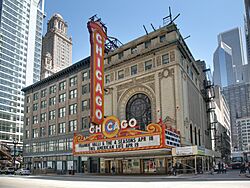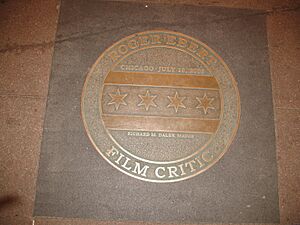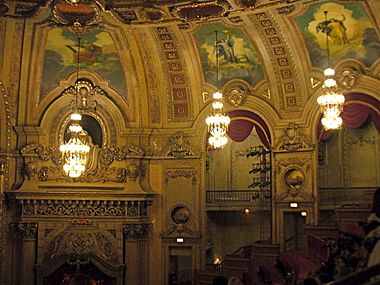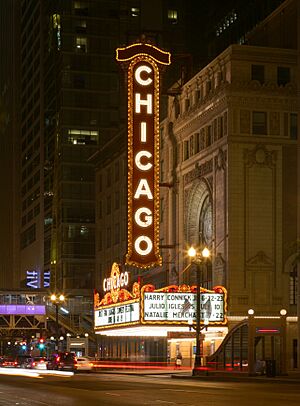Chicago Theatre facts for kids

Chicago Theatre in April 2009
|
|
| Address | 175 North State Street Chicago, Illinois 60601 |
|---|---|
| Public transit | Red at Lake |
| Owner | Madison Square Garden Entertainment |
| Capacity | 3,600 |
| Current use | music venue |
| Opened | October 26, 1921 |
| Website | |
|
Balaban and Katz Chicago Theatre
|
|
| Area | less than one acre |
| Architect | Rapp & Rapp |
| Architectural style | Neo-Baroque/Neoclassical (exterior); French Baroque (Neo-Baroque)(interior) |
| NRHP reference No. | 79000822 |
| Significant dates | |
| Added to NRHP | June 6, 1979 |
The Chicago Theatre is a famous building in Chicago, Illinois. It's a beautiful theater on North State Street. It first opened in 1921 and was known as the Balaban and Katz Chicago Theatre. This theater was the main one for the Balaban and Katz company. From 1925 to 1945, it was a very popular place to watch movies.
Today, Madison Square Garden Entertainment owns and runs the Chicago Theatre. It's a large place with 3,600 seats. People go there to see stage plays, magic shows, comedy, and music concerts.
The building is very important historically. It was added to the National Register of Historic Places in 1979. It also became a Chicago Landmark in 1983. The bright sign outside, called a marquee, is a well-known symbol of Chicago. You can often see it in movies, TV shows, and photos.
Contents
History of the Chicago Theatre
How the Theater Began

Abe and Barney Balaban, along with Sam and Morris Katz, started the Balaban and Katz theater chain. They built the Chicago Theatre in 1921. It was one of many fancy movie theaters they created. This theater became the most important one among their 28 theaters in Chicago. They also had over 100 others in the Midwest.
The main architects were Cornelius W. Rapp and George L. Rapp. The theater cost $4 million to build. The Rapp brothers designed many other theaters in Chicago, like the Oriental and Uptown Theatres. The Chicago Theatre was one of the biggest and most expensive movie palaces of its time. It is now the oldest grand movie palace still standing. It was also one of the first theaters built in the Neo-Baroque French-revival style. It is the oldest example of this style in Chicago.
When it first opened in October 1921, the theater had 3,880 seats. It was called the "Wonder Theatre of the World." Many people came to see the movie The Sign on the Door. There was also a 50-piece orchestra and a famous organist named Jesse Crawford. Poet Carl Sandburg wrote that police were needed to control the crowds. The theater offered a fancy place and great service, including early air conditioning. This idea was copied by theaters all over the country.
Famous Performers and Changes
For its first 40 years, the Chicago Theatre showed popular films and live shows. Many famous performers and stars appeared on its stage. One big attraction was live jazz music. Balaban and Katz started "Syncopation Week" in 1922, which was very popular. Jazz bands became a regular part of the theater's shows through the 1920s and 1930s.
The theater was redecorated for the 1933 World's Fair in Chicago. Artist Louis Grell repainted the murals inside the auditorium. This time, he chose Greek and Roman gods as the theme. These murals are still there today. Many famous events happened at the theater. For example, Ronald Reagan announced his engagement to Jane Wyman there. In the 1950s, the theater stopped having live stage shows.
In the 1970s, the theater faced hard times. It closed on September 19, 1985. The last movies shown there were American Ninja and Teen Wolf.
Bringing the Theater Back to Life
A group called the Chicago Theatre Preservation Group bought the theater in 1984. They started to fix it up in 1986. The renovation cost $9 million. Architects Daniel P. Coffey & Associates, Ltd. helped restore the theater to look like it did in the 1930s. It now has 3,600 seats.
The theater reopened on September 10, 1986, with a performance by Frank Sinatra. This was a big moment for the city. Sinatra had performed there in the 1950s, so his return was special. The renovation helped bring new life to the North Loop/Theatre District area of Chicago.
The Theater Today
In 2004, TheatreDreams Chicago, LLC bought the building. Then, in 2007, MSG Entertainment bought the theater.
Before 2008, the theater hosted the opening film of the Chicago International Film Festival. In 2005, Mayor Richard M. Daley declared July 12 "Roger Ebert Day in Chicago." A special plaque was placed under the marquee to honor him. The theater is also featured in a book about Chicago's movie palaces.
Since 2011, the tall CHICAGO sign on the outside has included the logo for Chase Bank. This shows that Chase Bank helps sponsor the theater.
Architecture and Design
The Chicago Theatre is seven stories tall. It takes up almost half of a city block. The front of the building on State Street has a large arch that is 60 feet wide and six stories tall. It looks like the famous l'Arc de Triomphe in Paris. Inside the arch, there is a round Tiffany stained glass window. It shows the symbol of the Balaban and Katz theaters: two horses holding film ribbons. The outside of the building is covered in off-white architectural terracotta with fancy designs.
The inside of the theater looks like a fancy French palace. The main lobby is five stories high. It has walkways on the mezzanine and balcony levels. This design was inspired by the Royal Chapel at Versailles. The grand staircase looks like the one in the Paris Opera House. It leads to the different balcony levels. Marshall Field and Company provided the drapes and furniture. The beautiful crystal chandeliers and bronze lights were made by Victor Pearlman and Co.
The stage is very large, over 60 feet wide and 30 feet deep. The orchestra pit is about 6 feet below the stage. It is 54 feet wide and 15 feet deep in the middle. Parts of the pit can be moved for different types of shows.
The theater's famous marquee has been changed a few times. The first one in 1921 was simple. The one from 1922-23 had bright flashing lights and swirls. The 1949 marquee was similar but had bigger signs for movie titles. The current marquee was put up in 1994. It looks like the older ones. In 2004, the original marquee was given to the Smithsonian Institution. The marquee is seen in many movies and TV shows set in Chicago. Its neon letters were even used in the title of the 2002 movie Chicago.
The Mighty Wurlitzer Organ
The Chicago Theatre is also known for its amazing Wurlitzer pipe organ. When it was first put in, it was called "The Mighty Wurlitzer." It could sound like many different instruments in an orchestra. Jesse Crawford, a famous organ player, helped design the organ and choose its sounds. This organ was built in July 1921. It has "four manuals and 26 ranks of pipes." It is one of the oldest Mighty Wurlitzer organs still in use today.









